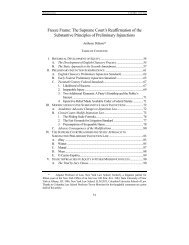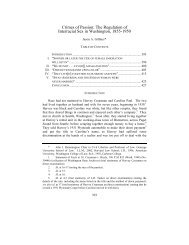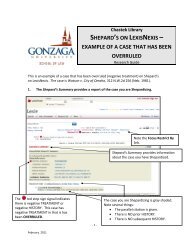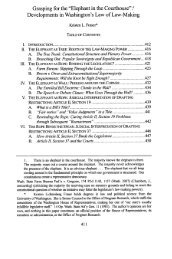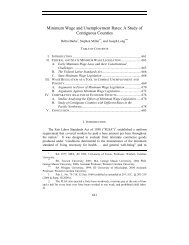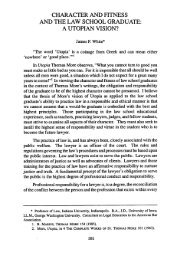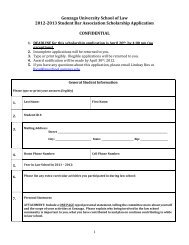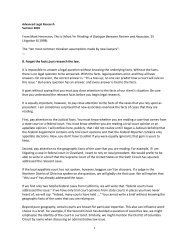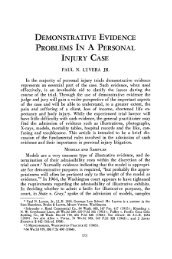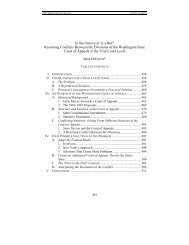professional responsibility, student practice, and the clinical
professional responsibility, student practice, and the clinical
professional responsibility, student practice, and the clinical
Create successful ePaper yourself
Turn your PDF publications into a flip-book with our unique Google optimized e-Paper software.
1990/91]<br />
STUDENT PRACTICE<br />
prepared <strong>and</strong> apprised of <strong>the</strong> facts, law <strong>and</strong> legal strategy necessary for<br />
competent representation in <strong>the</strong> specific case, it is less likely intervention<br />
would accomplish its intended purpose of remedying unsatisfactory <strong>student</strong><br />
performance. This is, of course, <strong>the</strong> worst of all possible situations for <strong>the</strong><br />
<strong>clinical</strong> teacher <strong>and</strong> a dilemma which, in itself, arguably constitutes<br />
un<strong>professional</strong> conduct. 6 ' While <strong>the</strong> chances of a conscientious <strong>clinical</strong><br />
teacher being totally unprepared to take over for a <strong>student</strong> are remote, <strong>the</strong><br />
teacher's level of preparation <strong>and</strong> knowledge will not be constant from case<br />
to case. A teacher's ability to improve on <strong>the</strong> performance of a <strong>student</strong> will<br />
be limited by <strong>the</strong> degree to which <strong>the</strong> teacher lacks relevant <strong>and</strong> specific<br />
information. To that same extent, <strong>the</strong> <strong>clinical</strong> teacher should exercise caution<br />
in assuming direct <strong>responsibility</strong> for representation. A conservative approach<br />
to intervention in such circumstances will also minimize any danger that <strong>the</strong><br />
uninformed teacher will merely substitute his or her style of advocacy or<br />
preferred choices for <strong>the</strong> disparate <strong>and</strong> possibly more thoughtful conduct of<br />
<strong>the</strong> <strong>student</strong>. 62<br />
5. Burdens on <strong>the</strong> Client <strong>and</strong> <strong>the</strong> System<br />
Issues raised by <strong>the</strong> fifth question relate to <strong>the</strong> need for intervention in<br />
those situations where <strong>student</strong> representation is not inimical to an ultimate<br />
outcome favorable to <strong>the</strong> client but significantly impacts <strong>the</strong> client or legal<br />
system in collateral ways. Even if interventi3n is not necessary to assure <strong>the</strong><br />
desired result, <strong>the</strong> <strong>clinical</strong> teacher should consider <strong>the</strong> consequences of <strong>student</strong><br />
performance in terms of delay, financial <strong>and</strong> emotional costs to <strong>the</strong> client, <strong>and</strong><br />
impact on <strong>the</strong> resources of <strong>the</strong> court <strong>and</strong> interested parties.<br />
A lawyer has a duty to "act with reasonable diligence <strong>and</strong> promptness<br />
in representing a client ' 63 <strong>and</strong> to make "reasonable efforts to expedite<br />
61. See MODEL RULES OF PROFESSIONAL CoNDucT Rule 1.1 <strong>and</strong> Rule 5.3 (1990).<br />
The development of <strong>professional</strong> <strong>responsibility</strong> "requires <strong>student</strong>s to be challenged by<br />
teachers who present role models which express that <strong>professional</strong> <strong>responsibility</strong> is<br />
important." Leleiko, Love, Professional Responsibility, The Rule of Law, <strong>and</strong> Clinical Legal<br />
Education, 29 CLEV. ST. L. REv. 641, 656 (1980).<br />
62. The <strong>clinical</strong> teacher has <strong>professional</strong> obligations to both <strong>student</strong> <strong>and</strong> client. This<br />
does not mean <strong>the</strong> teacher should simply substitute his or her decisions for those of <strong>the</strong><br />
<strong>student</strong> when both are reasonable under <strong>the</strong> circumstances. To do so would deprive <strong>the</strong><br />
client of <strong>the</strong> potential benefits flowing from a close working relationship with <strong>the</strong> <strong>student</strong>.<br />
It would also deprive <strong>the</strong> <strong>student</strong> of <strong>the</strong> opportunity to fully explore <strong>and</strong> test his or her<br />
decisions in a tolerant <strong>and</strong> encouraging environment.<br />
63. MODEL RULES OF PROFESSIONAL CONDucT Rule 1.3 (1990).



